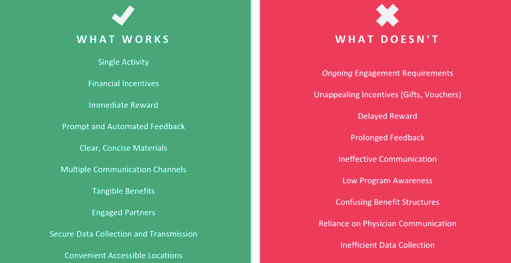According to a 2016 report from the U.S. Department of Health and Human Services, Medicaid covered approximately 70 million beneficiaries in 20151. Although growth in Medicaid enrollment has slowed recently, it nevertheless grew 3.9% in 2016 according to the Kaiser Family Foundation equating to more than 2.7 million new beneficiaries2.
Medicaid is faced with a disproportionate burden of the country’s chronic disease due to covering a large amount of minority, low income and undereducated individuals. In an effort to manage these populations, more health plans are adopting incentive-based programs that reward members for engaging in healthy behaviors. Although incentives are one of the most effective ways to promote participation, many programs still struggle to achieve successful engagement rates. The ever-elusive question remains: how do you create a wellness program that actually works?
Leveraging rewards is certainly a step in the right direction.
Although Medicaid programs have explored incentive-based initiatives in the past, the concept has gained significant traction since the introduction of Section 4108 in the Affordable Care Act in 2011.3 Section 4108, or “Medicaid Incentives for the Prevention of Chronic Disease,” allowed the Centers for Medicare and Medicaid Services (CMS) to award up to $85 million dollars for states to develop incentive programs targeting chronic disease.3 Since this initiative came into effect and ten states were selected for participation, the concept of utilizing incentives for Medicaid programs has continued to grow.3 While this is an exciting movement that shows promise and potential for positive public health outcomes, there is significant room for improvement as Medicaid continues to employ incentive-based models.
Achieving high engagement levels in any health program is challenging at best and seemingly impossible at worst. However, by studying human nature and closely observing past incentive programs, we learn helpful insights to shape successful future initiatives. Although we may always be searching for the magic answer that will solve wellness program deficiencies and produce tangible results, there are several things we do know about what works and what does not.

At a fundamental level, incentive-based Medicaid programs should be simple, actionable and financially valuable to the member (4). With this in mind, solutions should adhere to these core principles:
Offer an appealing incentive.
An attractive reward is one of the best ways to inspire effective behavior change. Incentive management should enable members to receive a cash-equivalent reward immediately after completing an activity. Because individuals are more sensitive to immediate benefits than delayed and distant rewards, providing an instant incentive directly after a desired behavior is key for driving participation.
Reward simple behaviors.
In a literature review about incentive effectiveness, 15 out of 17 studies that offered cash-equivalent rewards were successful in increasing rates of one-time behaviors (5). Similar studies of past Medicaid incentive programs demonstrate how the most successful initiatives involve simple, one-time actions, and members are more likely to complete programs where the required behaviors are single activities (a flu vaccine), as opposed to long-term commitments with ongoing engagement (a smoking cessation or weight loss program). Additionally, legacy programs still in place are often perceived as complicated and a lack of awareness and understanding is a challenge for many members. Members need to receive clear, easy-to-understand instructions that direct them towards simple activities.
Convenience is key.
Scheduling a doctor’s appointment, arranging for transportation and planning childcare are all common barriers that prevent members from completing certain healthy behaviors. Multi-channel wellness programs that are easy and accessible help members engage in their health in a convenient, familiar environment either on location or via the web.
All successful programs have one thing in common: they focus on the person. In order to be truly engaging, a program must not only consider—but prioritize—what a person wants, what they need, and what will motivate them to perform a desired action. This is the core concept we embrace in our consumer-focused approach to population health.
High-value population health platforms leverage principles of behavioral economics and real-time technology to promote sustainable health engagement and innovative quality improvement. Focusing on the consumer, solutions should be approachable, appealing, and built upon principles of ease, simplicity and convenience for members. In short, we must meet members where they are.
About the Author
Gillian Marshall is a Product Manager at Pursuant Health with a background in social marketing and health communication. Gillian earned a Master of Public Health in Health Promotion & Behavior from the University of Georgia and currently lives in Atlanta, Georgia.
1. Office of the Actuary, Centers for Medicare and Medicaid Services (2016). 2016 Actuarial Report on the Financial Outlook for Medicaid
2. Rudowitz, Robin, Valentine, Allison and Smith, Vernon (2016). Medicaid Enrollment & Spending Growth: FY 2016 & 2017. The Henry J. Kaiser Family Foundation
3. Crawford, M. and Onstott, M. (2014). Healthy Behavior Incentives: Opportunities for Medicaid. Retrieved from http://www.chcs.org/resource/healthy-behavior-incentives-opportunities-medicaid/
4. Blumenthal, K. J., Saulsgiver, K. A., Norton, L., Troxel, A. B., Anarella, J. P., Gesten, F. C., … & Volpp, K. G. (2013). Medicaid incentive programs to encourage healthy behavior show mixed results to date and should be studied and improved. Health Affairs, 32(3), 497-507.
5. Greene, J. (2007). Medicaid efforts to incentivize healthy behaviors. New Jersey: Center for Health Care Systems.
